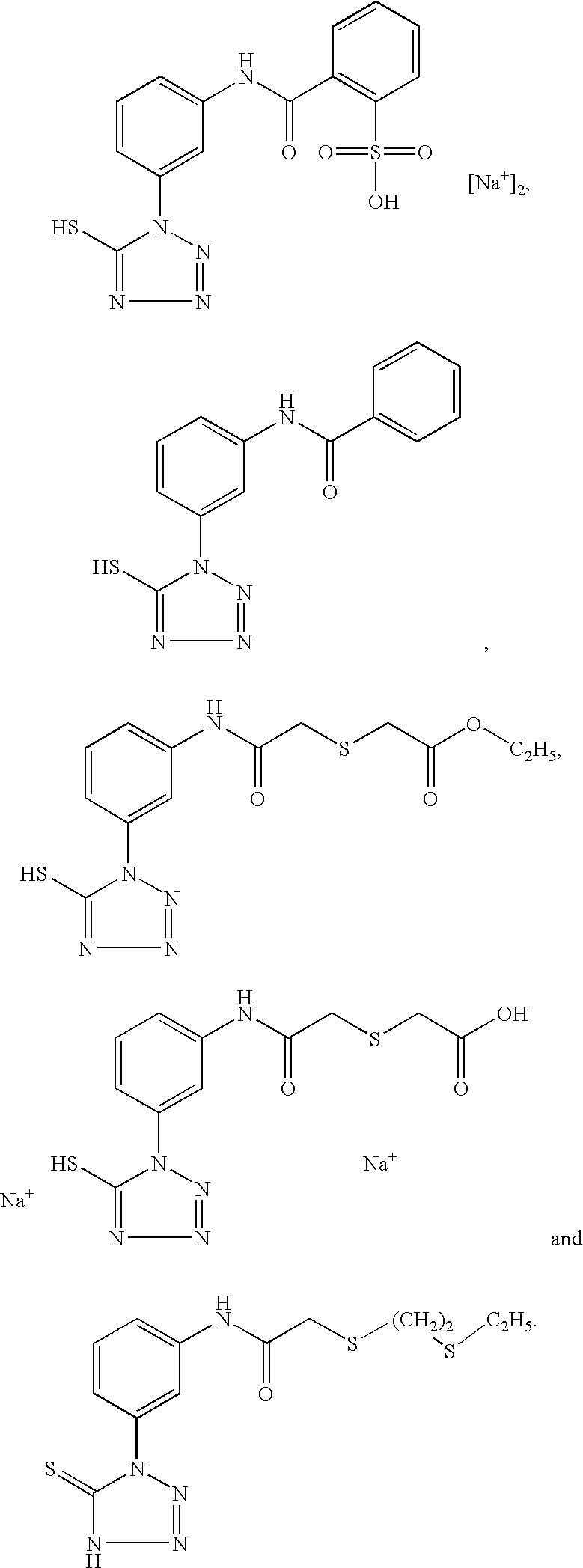Process for preparing a substantially transparent conductive layer configuration
a technology of substantially transparent conductive layer and configuration, which is applied in the direction of non-metal conductors, photosensitive materials, instruments, etc., can solve the problems of limited application, difficult to apply a thin layer, wetting problems, etc., and achieve the effect of improving flatness
- Summary
- Abstract
- Description
- Claims
- Application Information
AI Technical Summary
Benefits of technology
Problems solved by technology
Method used
Image
Examples
example 2 (
INVENTION)
[0153] Preparation of the Palladium Sulphide Dispersion:
[0154] The preparation of the physical development nuclei (PdS) is described in the example of EP-A 0769 723. From this example solutions A1, B1 and C1 were used to prepare the nuclei.
[0155] Preparation of Material D:
[0156] 100 g of the above-described PEDOT / PSS dispersion was mixed with 3.35 g of the PdS-dispersion. To this mixture, 1.25 g of a 10 g / L water solution of AEROSOL.TM. OT (American Cyanamid), 0.625 g of a 50 g / l solution of perfluorcaprylamidpolyglycol and 61.9 ml of water were added to give the coating dispersion. This dispersion was coated on a support consisting of a poly(ethylene terephthalate) film and a 4 .mu.m thick gelatin subbing layer to a wet-layer thickness of 50 .mu.m with a doctor blade and then dried for 15 minutes at 100.degree. C. to produce Material D.
[0157] Preparation of the Transfer Emulsion Layer:
[0158] The preparation of the silver chlorobromide emulsion and the preparation of the t...
example 3 (
INVENTION)
[0164] Conceptual experiments were carried out with a recorder film with a gelatine to silver ratio of 0.014. Exposed areas of 1.times.3 cm.sup.2 as electrodes with a separation of 40 .mu.m gave conducting silver patterns upon processing by conventional graphic processing. The resulting electrode pattern had a surface resistance of 50 to 100 ohm / square.
[0165] These electrodes were conditioned for 3 days at 35.degree. C. and a relative humidity of 80%. The aqueous solutions used for treating the electrodes prior to applying a potential of 100 V between neighbouring electrodes are listed in Table 3.
5TABLE 3 Solution Solution nr. active ingredient conc. (%] solvent 1 STAB01 (1-phenyl-5-mercapto-tetrazole) 1.0 water* 2 STAB01 0.1 water* 3 STAB01 + Antarox .TM. CO 630# 1.0 + 0.5 water 4 STAB01 + Antarox .TM. CO 630# 0.1 + 0.5 water 5 STAB02 (sodium tartrate) 10 water 6 STAB02 (sodium tartrate) 1 water 7 STAB03 (thiourea) 10 water 8 STAB03 (thiourea) 1 water 9 STAB04 (sodium sul...
PUM
| Property | Measurement | Unit |
|---|---|---|
| Fraction | aaaaa | aaaaa |
| Fraction | aaaaa | aaaaa |
| Width | aaaaa | aaaaa |
Abstract
Description
Claims
Application Information
 Login to View More
Login to View More - R&D
- Intellectual Property
- Life Sciences
- Materials
- Tech Scout
- Unparalleled Data Quality
- Higher Quality Content
- 60% Fewer Hallucinations
Browse by: Latest US Patents, China's latest patents, Technical Efficacy Thesaurus, Application Domain, Technology Topic, Popular Technical Reports.
© 2025 PatSnap. All rights reserved.Legal|Privacy policy|Modern Slavery Act Transparency Statement|Sitemap|About US| Contact US: help@patsnap.com



